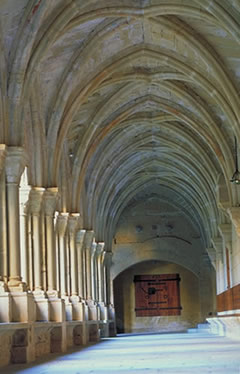Later History
Medieval Developments and Decline

Vaulting in the Abbey of Poblet, Spain.
Growth introduced diversity in both discipline and priorities. Geographic distances and historical upheavals weakened the visitation system and handicapped the General Chapters. The order was especially driven into decline by the late-feudal institution of "commendatory abbots" (in which external powers would grant abbatial authority as a political favor to lay nobles, who could then administrate "their monasteries" for personal gain) and by the crisis of the Protestant Reformation and its subsequent wars, revolutions, and suppressions.
Efforts of renewal and reform in the 16th century ultimately split the order into two observances ("common" and "strict"), rival camps entangled in both local political intrigues and disagreements about the monastic vocation. The French Revolution of 1789 extinguished Cistercian life in France. Soon thereafter the monasteries of Italy, Spain, and Catholic Germany fell victim to "secularization" at the hands of political rulers. Only in the Hapsburg Empire were a handful of monasteries able to sustain a continuous existence from the first Cistercian generation.
New Beginnings in the 19th-Century
The reconstruction of Cistercian life took place locally, on a grassroots basis. In France, a number of the abbeys of the "strict observance" were revived in the tradition of the seventeenth-century reform of the Abbey "de la Trappe" and its highly penitential interpretation of the Benedictine Rule. The surviving monasteries of the "common observance" also began to re-found a number of secularized monasteries in German and Italian regions and in Central Europe. Thus local "congregations" of abbeys emerged and renewed themselves, typically independently of one another.

The ruins of the Abbey of Rievaulx, England, by Rob Bendall.
A notable measure of plurality emerged as a fact of Cistercian monasticism in the wake of early modern politics and its ravages against the Church. The demands of providence upon monasteries were both immense and diverse. At the same time, the order's original cohesion under the Abbot of Citeaux had been destroyed with the suppression of the French abbeys after the revolution of 1789, and the order's General Chapter was unable to reconvene between that time and 1869. The resultant disarray and non-communication inspired Pope Pius VII in 1814 to mandate the establishment of a Cistercian "President General", a leader for the order who would also be the abbot of Santa Croce, a common observance monastery in Rome. Broad tensions between the strict observance and the common observance emerged as irresolvable, however, and in 1893, with the endorsement of Leo XIII, three congregations of strict observance monasteries formed a separate order under the name of "Cistercians of the Strict Observance" or "Cistercians of Our Lady of la Trappe"; hence their frequently used name, "Trappists". The remaining monasteries continued the tradition of grouping themselves into regional congregations, although their unity was further advanced by renewed General Chapters and their ability to elect a single Abbot General to serve the order internationally.

